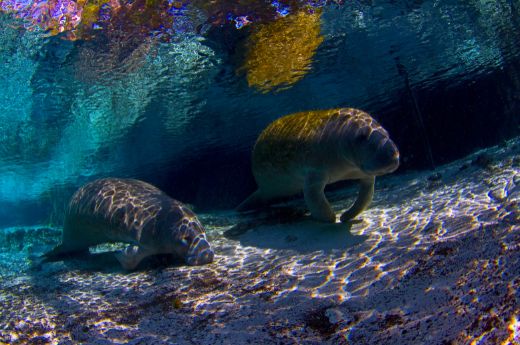In the year 2022, already over five hundred manatees have died. The threats manatees are facing continue to increase, and manatee habitats keep taking environmental hits.
Manatees are gentle, slow-moving mammals that live in our oceans and rivers. They are herbivores that snack mostly on a variety of grasses giving them the nickname, sea cows.
However, this food of choice, along with other parts of their habitat, is being contaminated and causing the manatee population to dwindle once again. We are going to be revealing the top five threats to manatees, and what we need to be focusing on to save the manatee's population. Come read along!
1. Boats & Fishing Gear
Manatees mostly live and feed in shallow waters. Costal ways, canals, and rivers make perfect habitats for these mammals. Unfortunately, this makes them prime targets for boats and fishing gear.
About 20% of manatee deaths have been attributed to watercraft encounters. Even though manatees are relatively big creatures reaching about nine to ten feet long, when boats are speeding through inland waterways, they are hard to spot.
Manatees are extremely susceptible to cold temperatures. For this reason, they don't venture too deep unless there is a storm. This means that they are often accidentally entangled in fishing gear.
While they can hold their breath for twenty minutes, these sea cows still need air to breathe. They make frequent trips to the surface to fill their lungs back up. When they are caught in fishing nets, they can't make it back up to the surface, so they drown.
2. Starvation from HAB
In 2021, there were record numbers of deaths in the manatee population due to starvation in Florida. Because of their vegetative diet, Manatees rely on seagrass for nourishment.
A rise in HAB, or Harmful Algal Blooms, has caused rapidly declining rates of this manatee food source. Needing sustenance, manatees are eating what's left of the affected sea grass, which is contributing to another issue, poisoning.
This phenomenon called "red tide" makes the sea grass toxic. After ingesting and creating a buildup of these toxins, it causes seizures and drowning in manatees.
3. Pollution
The driving contributor to HAB is manmade pollution.
A great example of this is Piney Point. The phosphate plant has come under fire for releasing several million gallons of wastewater into coastal waters.
HRK Holdings foolishly were relying on a simple, plastic liner to hold back two hundred million gallons of chemically altered water. The liner failed to do what it was supposed to do, and now the marine life in Tampa Bay, Florida is suffering for it.
Alongside chemical pollution, plastic pollution is destroying manatee habitats and killing manatees. Plastic bags floating through the ocean are being ingested and getting caught up in manatees' digestive tracts.
These creatures have been found dead and from postmortem studies, they have found plastic bags like a rope traveling from their stomach to intestines.
Another instance found a manatee entangled in a plastic bag for two years leaving an open wound. Again, because they swim through shallow waters where debris is caught on vegetation, manatees easily get snagged and caught up in our trash.
4. Poaching
The illegal hunting of manatees may seem reprehensible and archaic. However, it is still happening, and Antillean manatees especially are at major risk.
The West Indian manatees are hunted for their fat, hide, and meat. While an interesting food source for humans, this is exactly why some parts of South America are still hunting these gentle creatures.
5. The Temperature of Manatee Habitats
Changing water temperatures are a danger to manatees and their living environments. As discussed, manatees are susceptible to cold temperatures. This is because they are at risk of hypothermia just like humans!
Cold temperatures bringing on hypothermia and frostbite rank as one of the highest non-human-related causes of death for manatees. Cold fronts and inclement weather lower the temperature of the water, and when it drops below sixty-eight degrees manatees that haven't left their home for warmer temperatures die.
Having less blubber than other sea creatures like seals and whales, manatees are prone to something called cold stress. This means that as they lose their body heat they also stop digesting their food, which in turn, is fatal.
Conservation Efforts
In hopes of helping the manatee population, there are a number of both federal and state laws in effect to protect them. The Endangered Species Act and the Marine Mammal Protection Act are two federal laws by which the manatee is covered.
The state of Florida is a sanctuary and refuge for these sea cows and has stepped up by enforcing rules and regulations. Florida Fish and Wildlife Conservation Commission, FWCC, is authorized to adopt and enforce them. For example, one of the regulations restricts boat speeds and handling to try to decrease the number of manatee boating collisions.
The FWCC also is in charge of protecting their habitats. This means that they are designating safe havens that are undisturbed by humans; areas of seagrass for rest and reproduction.
The commission is currently working on The Manatee Recovery Plan. In this plan, they are aiming to reduce the threats above that make manatees endangered, and seek to lower occurrences of manatee harassment.
What You Can Do
We all have a part to play in making manatee habitats safer. Some easy, practical things you can do are:
- Throw away your trash
- Follow boating laws
- Support and donate to manatee conservation efforts
- Spread the word
Furthermore, never feed wild animals, in this case, manatees, because you attract them to their number one cause of death, man. If you see an injured manatee, call 1-888-404-FWCC instead of trying to help it yourself. Both you and the animal could be injured.
A great way to bring attention to manatees is to broadcast them with your attire. Check out some of our cute t-shirts you can showcase this summer!

